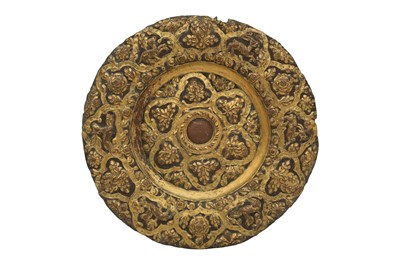28th Oct, 2022 14:00
Islamic & Indian Art
A GILT COPPER (TOMBAC) SERVING DISH WITH REPOUSSÉ ANIMAL MOTIFS
Balkans, Western Ottoman Provinces, 16th - 17th century
A GILT COPPER (TOMBAC) SERVING DISH WITH REPOUSSÉ ANIMAL MOTIFS
Balkans, Western Ottoman Provinces, 16th - 17th century
Of shallow circular shape, resting on a heavily embossed base, with a short curved cavetto and wide everted rim, the copper body heavily gilt and worked with repoussé floral and animal motifs, the centre with a stylised floral medallion with six petals, each one filled with lush foliage and flowers in relief, the rim with interlocking lobed cartouches alternating rosettes and foliated bunches with wild animals like deer, wolf, hare, and goat, surrounded by further floral patterns and vegetal festoons, the base with an old inventory label from a private collection in Vienna and the number 307, 29cm diam.
From the 14th to the 16th centuries, the Ottoman expansion in the Balkan territories rewarded the Turks not only with access to important silver mines like Novo Brdo and Srebrenica but also with the long-standing cultural and artistic traditions and bright talent of Balkan silver and goldsmiths. In this period, local techniques, together with late Byzantine influences, and Ottoman motifs were all amalgamated into a heterogeneous style often referred to as pan-Balkan. Several creations have surfaced through the years, and many showcase a strong degree of uniformity in their decorative vocabulary, often earning these items the classification of 'Animal Style' due to the recurrent presence of wild animals on their borders, cavettos, or exteriors (Nicholas Shaw in Turkophilia revealed: Ottoman art in private collections, Sotheby's France, 2011).
Another recurrent name for the style developed in this period in the Ottoman-occupied Balkan Provinces is Moravska (after the Morava river). It consists of interlacing ornaments combined with figures of fantastic and wild animals in high relief, amidst naturalistically swelling leaves, flowers, and interlocking double palmettes. Balkan silver and goldsmiths scarcely had the opportunity to realise secular articles, but they continued working for the Church, which meant that their creations were to be mostly used for ceremonial functions in a religious context. Nevertheless, their creativity did not seem to be affected by these limitations and these talented craftsmen produced vessels showing figures full of movement, set in arabesque-like medallions borrowing elements of the decorative vocabularies of both Byzantine and Turco-Persian arts (Masterpieces of Serbian Goldsmiths' Work, 13th-18th Century: An Exhibition, Muzej Primenjene Umetnosti in Belgrade, Serbia, and Victoria and Albert Museum, in London, 1981, pp. 9 - 12).
For further comparison between our plate and other Balkan repoussé vessels which recently appeared in the London auction market, please see Christie's London, 6 October 2011, lot 308 and 25 April 2013, lot 255; and Sotheby's London 24 April 2012, lots 118 and 165.
Do you have an item similar to the item above? If so please click the link below to submit a free online valuation request through our website.




